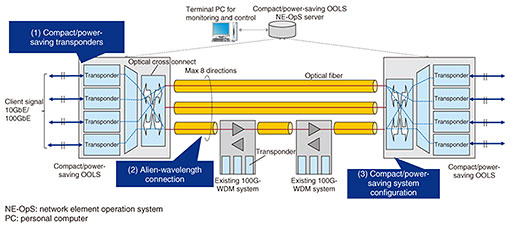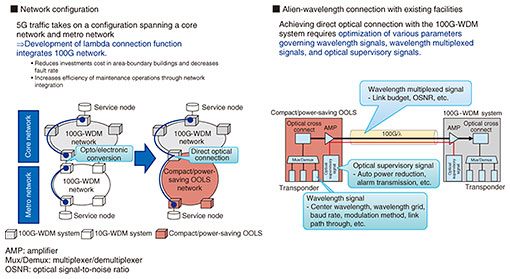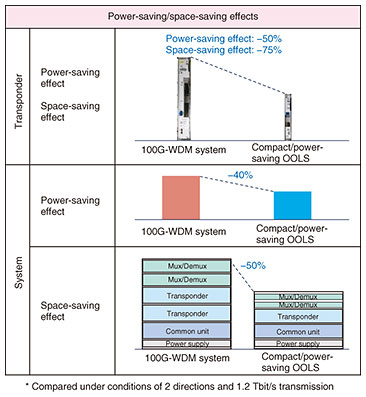 |
|||||||||
|
|
|||||||||
|
Regular Articles Vol. 20, No. 9, pp. 76–80, Sept. 2022. https://doi.org/10.53829/ntr202209ra2 Development of Compact/Power-saving Optical Open Line SystemAbstractNTT Network Innovation Center has developed a compact/power-saving optical open line system that can provide optical transmission of 100 Gbit/s per wavelength in an economical, space-saving, and power-saving manner. The goal with this system is to achieve large-capacity transmission up to edge buildings in the metro network to deal with the rapid increase in traffic accompanying the introduction of the 5th-generation mobile back haul. This article presents an overview of this system and its features. Keywords: optical transport, DWDM, compact/power-saving 1. Capacity enhancement in core and metro networksTo deal with increasing volumes of traffic driven by the expanded use of smartphones, cloud services, video delivery services, etc., the optical transport network of the NTT Group has up to now been using a wavelength division multiplexing (WDM) system at 100 Gbit/s per wavelength for the core network. At the same time, traffic across the entire network up to edge buildings located in rural areas is predicted to increase with the introduction of the 5th-generation (5G) mobile back haul (MBH), so even metro networks will require greater capacities. However, issues with the current 100G-WDM system in terms of installation space and power consumption have hindered its implementation, so we developed a compact/power-saving optical open line system (OOLS) that greatly reduces the amount of space needed for installation and the amount of power consumed. This system will enable system configurations that optimize installation space and power consumption in accordance with traffic volumes driven by diverse service demands. 2. Technical features of the compact/power-saving OOLSThe system configuration of the compact/power-saving OOLS is shown in Fig. 1. This is an optical transport system based on digital coherent technology and dense WDM, which transmits multiple wavelength signals in a single fiber. It achieves a maximum transmission capacity of 8 Tbit/s by multiplexing 100-Gbit/s-per-wavelength signals over a maximum of 80 wavelengths. The system includes an optical cross-connect function that enables add, drop, or through settings for any optical path in a maximum of eight directions. It can also connect with an existing 100G-WDM system without converting optical signals to electrical signals, which can make effective use of existing facilities. For this compact/power-saving OOLS, we developed technology for a system configuration conducive to advanced optical devices and compact/power-saving characteristics with the above specifications and succeeded in achieving a compact and power-saving system. The main features of this compact/power-saving OOLS are (1) compact/power-saving transponders, (2) alien-wavelength connection, and (3) compact/power-saving system configuration.
2.1 Compact/power-saving transpondersThis compact/power-saving OOLS consists of multiple transponders, each of which converts a client signal used for connecting this system to a service node to a wavelength signal or vice versa. Each transponder features a compact and power-saving configuration by using advanced devices such as a coherent optical subassembly (COSA) [1], low-power digital signal processor (DSP), and compact optical module. A COSA is a silicon photonics device developed by NTT Device Innovation Center integrating an optical modulator, optical transceiver, and analog integrated circuit (IC) on one chip. Combining the COSA with a DSP developed by NTT Network Innovation Laboratories and maximizing transmission characteristics has enabled L-band transmission and the mounting of these devices on a compact/power-saving OOLS transponder (Fig. 2). In addition, the 100GbE optical module used to connect this OOLS to a service node adopts a quad small form-factor pluggable 28 (QSFP28) downsized from the conventional centum gigabit form-factor pluggable, resulting in a compact form factor approximately one-fourth the current size.
2.2 Alien-wavelength connectionThe 5G MBH takes on a configuration spanning a core network constructed using an existing 100G-WDM system and a metro network scheduled to be constructed using the compact/power-saving OOLS. For constructing optical paths across different networks in the conventional transmission system, it was necessary to execute a one-time electric-optic conversion using a transponder, which was a problem in terms of facility costs. We therefore developed an alien-wavelength connection function in the compact/power-saving OOLS to enable direct connection of optical signals without electric-optic conversion with the existing 100G-WDM system. This scheme achieves a sustainable system through effective use of the existing 100G-WDM system while reducing investment costs and improving maintenance and operations with network integration. A network configuration using the alien-wavelength connection with existing facilities and a function overview are shown in Fig. 3.
A WDM system uses wavelength signals (output from transponders), wavelength multiplexed signals (that multiplex wavelength signals for long-distance transmission), and optical supervisory signals (used for setting and controlling equipment, transmitting alarms, etc.). In the compact/power-saving OOLS, various parameters for those wavelength signals, wavelength multiplexed signals, and optical supervisory signals are optimized to achieve the alien-wavelength connection with the existing 100G-WDM system. 2.3 Compact/power-saving system configurationThe compact/power-saving OOLS reduces the size and power consumption of the entire system by improving the system configuration conducive to downsizing and power saving in addition to applying advanced devices such as a COSA and DSP. Conventional WDM systems have taken on a unit configuration or package-mounted configuration under the assumption of using with a maximum number of directions and wavelengths. Applying such a system to a building using a small number of directions or wavelengths results in unnecessary (empty) slots, which is an inefficient implementation. In response to this problem, we developed a compact unit for the compact/power-saving OOLS that reduces the number of packages that can be mounted for buildings having small-scale demands such as a small number of paths or wavelengths and downsized the package configuration by consolidating function sections and high-density mounting. Regarding reducing package size, we achieved high-density system mounting without decreasing maintenance work efficiency for insertion/removal of optical cable connectors, packages, etc. We also developed a unit for mounting on general-purpose racks to enable a transition from large specialized racks, as used in the past, to general-purpose small racks. By applying these compact/power-saving system configurations to the compact/power-saving OOLS, we achieved downsizing by approximately 50% and power savings by approximately 40% over the entire system compared with conventional 100G-WDM systems (Fig. 4).
3. Conclusion and future perspectiveThe compact/power-saving OOLS has achieved large-capacity transmission and compact/power-saving configuration for a more economical transport network. NTT is now conducting research and development for the All-Photonics Network (APN) [2]. The APN is one of the innovative optical transport platforms for IOWN (the Innovative Optical and Wireless Network). We are aiming to further speed up signal per wavelength such as 400-Gbit/s or 1-Tbit/s. We will also target further high-capacity transmission by using multi-band transmission [3] to expand the transmission wavelength range or using space-division multiplexing technology such as multi-core fiber [4]. We will continue to conduct research and development for further improving optical transport systems and for dramatically expanding the transmission capacity. References
|
|||||||||











